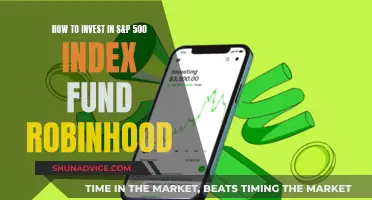Tracker funds, also known as index funds or passive funds, are a type of investment fund that mirrors the performance of a benchmark or market index, such as the FTSE 100 or S&P 500. They aim to replicate the returns of these indices by investing in the same assets, offering investors a low-cost way to gain exposure to a wide variety of shares, commodities, or bonds. Tracker funds are passively managed, meaning they are run by computer algorithms rather than costly research and fund managers, making them a cheaper alternative to actively managed funds. However, it's important to note that tracker funds will never outperform the market or index they are linked to.
| Characteristics | Values |
|---|---|
| Type of Investment | Passive investment, pooled investment, collective investment scheme |
| Management | Passive, index fund management, automated computers, professional investment management firm |
| Cost | Low cost, low annual fee, low upfront cost |
| Risk | Lower risk than active funds, but still subject to market risk |
| Performance | Attempts to replicate the performance of a market index, may underperform in certain sectors or regions |
| Tax | Can be held in a tax-free Individual Savings Account (ISA) |
| Accessibility | Easy to buy and sell, can be traded on the stock exchange |
| Diversification | Offers broad exposure to the financial markets, may be more or less diversified depending on the index tracked |
| Customisation | Customised indexes available, but investors cannot choose what goes into the fund |
What You'll Learn

Tracker funds are passive investments
Tracker funds are also passive because they are designed to replicate the performance of a designated market index. Index fund management is driven by tracking functions, and tracker funds seek to replicate the holdings and performance of the market index. Tracker funds are constructed as ETFs (exchange-traded funds) or alternative investments to meet their tracking objectives.
Tracker funds are a good option for those who want to take a passive investing approach. They are also a good choice for those who want to invest but do not have a high level of financial knowledge.
Unlocking the Schiehallion Fund: A Guide to Smart Investing
You may want to see also

They are low-cost investments
Tracker funds are a type of passive investment fund, meaning they require little input from the investor. They are also known as index funds, designed to offer investors exposure to an entire index at a low cost. This is because they are run using computer algorithms rather than costly research and managers. Tracker funds are pooled investments, which means they aggregate sums of money from lots of different people into one large fund, allowing it to be managed on their behalf by a professional investment management firm.
Tracker funds are very low cost compared to active funds. They are cheap to run because they are mostly automated, and the makeup of the indexes they track does not change much over time, so transaction fees are few and far between. This means that the annual fee for these funds tends to be extremely low. On average, the average annual management fee is around 0.06%. This means for every £1,000 invested, a shareholder would need to pay approximately 60p a year.
Tracker funds are also low cost because they are passively managed. This means they aim to replicate the performance of a particular stock market index, rather than trying to beat it. This is in contrast to actively managed funds, which are run by professionals who pick specific stocks in an attempt to beat an underlying index. Because of this, tracker funds can never outperform the market or index they are linked to – as the name suggests, they will only ever follow it. However, statistics have shown that actively managed portfolios frequently fail to beat their benchmarks and often charge higher fees than passive funds. According to research from AJ Bell, only a third of active equity funds managed to beat their passive alternatives in 2021.
Tracker funds are also low cost because they are diversified. When you invest in a tracker fund, your money is pooled with other investors, and together you own a certain set of assets. This provides the investors with a more diverse portfolio compared to buying, say, just a handful of stocks. This diversification means that if one company or asset underperforms, this may be offset by another asset outperforming, meaning that investors receive the average return over all of the assets.
Tracker funds are a popular form of investment that offers investors exposure to a wide variety of shares, often at a relatively low cost. They are a simple and cost-effective way to invest, particularly for those who want exposure to global markets but don't want to spend a lot of time picking a fund.
The S&P 500 Index Fund: Your Easy Investing Guide
You may want to see also

They are diversified investments
Tracker funds are diversified investments. They are designed to offer investors exposure to a wide range of assets, from individual sectors to entire stock market indices. This means that if you invest in a tracker fund, you will be investing in a variety of different companies or assets, which can help to reduce your risk.
For example, a Nasdaq 100 tracker fund will mirror the price movements of the companies in the Nasdaq 100 index. It does this by purchasing shares in the companies included in the index relative to their index weighting. So, if you invest in a Nasdaq 100 tracker fund, you will be exposed to the US tech sector without having to buy individual shares in dozens of different companies.
Tracker funds can also be structured as unit trusts or open-ended investment companies (OEICs), which can invest in a portfolio of shares, bonds, property, commodities, or a combination of different asset classes. This means that your investment is not tied to the performance of a single company or asset, and you benefit from a diversified portfolio.
In addition, tracker funds are often cheaper than active funds, as they are run using computer algorithms rather than costly research and managers. This makes them a cost-effective option for investors who want a diversified portfolio.
However, it is important to note that tracker funds will never outperform the market or index they are linked to – as the name suggests, they will only ever follow it. So, while tracker funds offer diversification, they may not provide the same potential for high returns as investing in individual stocks.
Index Funds: A Beginner's Guide to Investing in Australia
You may want to see also

They are simple to invest in
Tracker funds are simple to invest in. They are passive investments, meaning that you only need to buy shares in the fund itself. You don't need to worry about choosing which assets go into the fund and you don't need a high level of financial knowledge because the fund provider will take care of that for you.
Tracker funds are also simple to invest in because they are very low cost compared to active funds. They are run using computer algorithms rather than with costly research and managers, so they are cheaper than actively managed funds. The average annual management fee is around 0.06%, which means for every £1,000 invested, a shareholder would need to pay approximately 60p a year.
Tracker funds are also simple to invest in because they are diversified. Their value is determined by the share price of a collection of different companies, so if one of these companies' stocks falls in value, it is unlikely to have a large effect on the performance of the fund as a whole.
Finally, tracker funds are simple to invest in because they are flexible. They can be structured as a unit trust or open-ended investment company (OEIC), or as an Exchange-Traded Fund (ETF). While unit trusts and OEICs are valued and dealt with the manager once a day based on the value of the underlying assets held by the fund, ETFs are bought on the stock exchange at any time throughout the day just like shares.
Index Funds vs Savings: Where Should Your Money Go?
You may want to see also

They are a good alternative to active funds
Tracker funds are a good alternative to active funds for several reasons. Firstly, they are considered ''passive investments", meaning that investors only need to buy shares in the fund itself without worrying about choosing the specific assets that go into the fund. This makes tracker funds more accessible to individuals who may not have a high level of financial knowledge or the time to actively monitor and manage their investments.
Secondly, tracker funds are generally cheaper than active funds. Tracker funds are often run using computer algorithms, eliminating the need for costly research and managers. This results in lower fees for investors, which can add up to significant savings over time.
Thirdly, tracker funds offer diversification, as their value is determined by the share price of a collection of different companies. This means that if one company's stock falls, it is unlikely to significantly impact the performance of the fund as a whole.
Finally, tracker funds provide broad exposure to financial markets at lower upfront costs compared to buying each asset individually. This makes them a cost-effective way for investors to gain exposure to a wide range of shares or other assets.
While tracker funds have many advantages, it is important to consider their limitations. For example, tracker funds do not allow investors to choose what goes into the fund, and they do not grant direct ownership of any shares or assets. Additionally, it is important to assess the underlying fees associated with tracker funds, as these can vary.
Fidelity Index Funds: Smart, Secure, Long-Term Investment Options
You may want to see also







